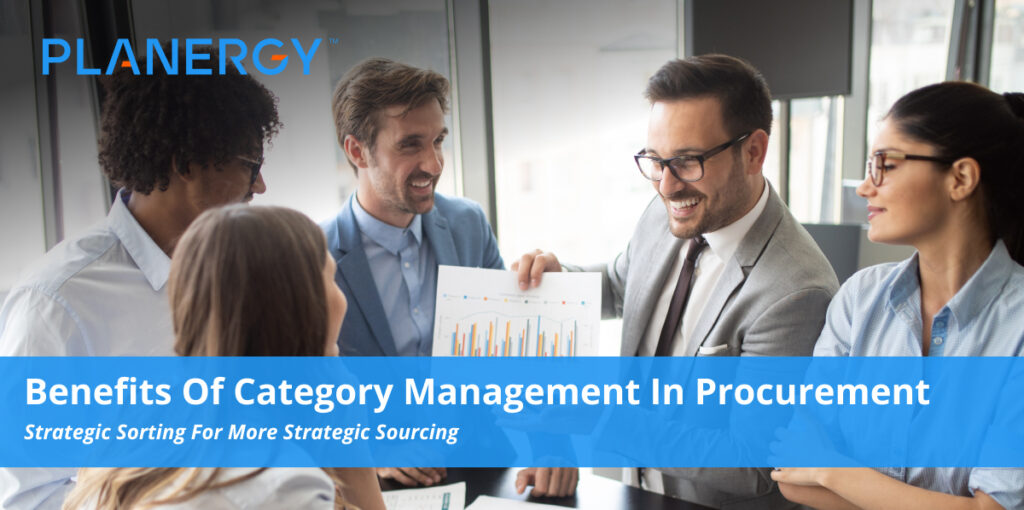Your company’s supply chain isn’t just a connection to the goods and services you rely on for doing business—it’s an essential component in your company’s overall business process management and competitive performance strategies.
A strong and strategic supply chain helps you generate value through effective supplier relationship management, the highest possible return on investment (ROI), and lowest total cost of ownership (TCO).
And one of the most important, and effective, tools in building an optimized supply chain is through effective category management.
Once you understand the benefits of category management in procurement, you’ll be well-positioned to organize your suppliers and build smart, strategic relationships that will help your business compete, grow, and thrive with peak performance and efficiency.
What Is Category Management in Procurement?
Every company spends money on goods and services. Supply chains vary in size and complexity, but they all have a variety of suppliers who are each organized into one or more categories, overseen by category managers.
These specialists have advanced knowledge of their assigned products, market, and suppliers, and use their expertise to secure savings and value while managing their company’s supplier relationships to minimize risk.
A successful category management process involves organizing similar or interrelated goods and services into specific categories in order to leverage opportunities for consolidation, contingency development (as a function of business continuity planning, for example), and improving supply chain performance, value, and savings.
Some of the most common methods for organizing goods and services include item or service type, specific vendor, and purchase volume.
It is a centralizing process that provides a comprehensive view of the entire supply chain while simultaneously allowing procurement teams to perform detailed spend analysis on specific categories to monitor supplier performance, extract market intelligence, and leverage economies of scale to secure the maximum possible return on every dollar spent while minimizing operational risk.
Chief procurement officers (CPOs) and other procurement professionals develop their category management approach to match their overall business strategy and organizational goals.
With the growing importance of digital transformation in shifting procurement functions into the role of value centers for the organizations they serve, companies are also adding digital tools such as artificial intelligence, data centralization and management, and process automation to their category management toolkit through the implementation of eProcurement software.
This technology, combined with well-trained category managers and well-developed category strategies, provides an essential part of strategic sourcing and are critical to realizing procurement-guided cost savings along with value via more effective risk management and stronger supplier relationship management.
Your supply chain can be a lifeline to incredible success—or a tangled snarl of excess risk and costly inefficiencies that threaten not just your bottom line, but the survival of your business.
Key Benefits of Category Management in Procurement
As your procurement team develops its category management strategy, you can match your company’s goals for growth, risk, and competitive advantage with your approach to your category plan to maximize the impact of spend analysis, supplier relationship development, etc.
The scope of work—including concerns such as how much operational risk comes with your current supply chain, the number of different categories and subcategories you need to effectively manage your supply base, and the state of the supply market for your particular industry and vertical—will vary.
But if you take a proactive and strategic approach to category management, you can expect to see a range of benefits, including:
More Valuable Insights for Better Decision-Making
Data analysis is a powerful tool every department and business unit can use to harvest actionable insights from the information streaming into and out of their organizations.
In category management, having the option to “slice and dice” your supply chain spend data in various ways while also incorporating market intelligence gathered through market analysis makes it possible to:
- Manage specific vendors and entire categories to align with organizational goals for profitability, performance, and risk management.
- Engage in negotiations with complete and accurate data to secure optimal pricing and terms, leveraging economies of scale and capturing discounts where appropriate.
- Identify potential supply chain disruptors—including pandemics such as COVID-19, natural disasters such as the Amazon and US wildfires, and international conflicts—and create contingency plans that protect business continuity while still keeping risk to a minimum.
- Focus the time and talents of category specialists on building strong, strategic supplier relationships and collaborating to promote shared success through partnerships, new markets and products, etc.
Improved Supplier Performance—and Relationships
Category management is about more than sorting data. With a clear category plan and skilled team members, team members can:
- Recruit, evaluate, and onboard new suppliers more quickly and easily.
- Provide a value-based, communicative, and collaborative level of personalized service to suppliers (particularly key suppliers), improving both the chance of opportunities for shared growth and negotiation strength.
- Clear and complete supplier performance and compliance data allows category managers to rehabilitate or replace underperforming suppliers to reduce risk or upgrade and expand the role of other suppliers to support supply chain resilience and insulate the company against disruptions.
A Complementary Partner for Strategic Sourcing
Forward-looking and proactive, category management strategies are a strong complement to reactive strategic sourcing strategies. In fact, effective category management is itself an essential part of strategic procurement.
How? Category management programs do the “frontloading” for value and savings. Category managers use their expertise (along with tech tools) to organize their specific categories and subcategories, work with new and existing vendors to provide optimal ROI with minimal risk, and generally promote a friendly, open approach to supplier relationship management.
They may use existing spend data in refining their particular areas of the supply chain, and rely on more advanced data analysis when crafting for resilience and risk reduction as well as savings and business continuity.
Reactive strategic sourcing also relies heavily on data analysis, and can provide additional supply market intelligence that helps your team to improve category management, which in turn provides greater efficiency, lower supply chain risk and stronger supplier relationships.
Every iteration provides continuous improvement and opportunities to capture more value, slash more risk, and leverage insights to secure new markets, develop partnerships that support new products and innovation, and manage valuable intangibles such as company reputation, environmental footprint, and customer satisfaction.
Substantial as they are, these benefits don’t happen on their own—you need a successful category management strategy.
You can boost the odds of securing these benefits for your own procurement organization by following best practices in category management as part of your overall procurement strategy—and implementing a comprehensive, cloud-based, and data-driven procurement solution such as PLANERGY.
Doing so won’t only help you achieve more value from category management, but help you streamline all your procurement processes for greater value, higher performance, and lower costs.
Build a Responsive, Resilient Supply Chain with Category Management
Your supply chain can be a lifeline to incredible success—or a tangled snarl of excess risk and costly inefficiencies that threaten not just your bottom line, but the survival of your business.
Make sure your team knows the benefits of effective category management in procurement so they can develop and implement a category plan focused on organizing your supply base for better decision making and insulation against the disruptions that can prove costly or even fatal to an unprepared business.




